Project Kawasaki KLX110: Testing Lights for Night Riding
Trailtech halogen headlight and Cyclops Solstice HID helmet light
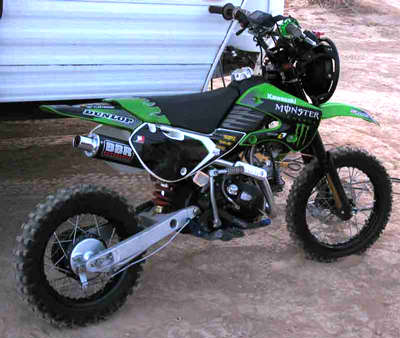 With the Southern California deserts running consistent temps over 100 degrees there hasn’t been a lot of opportunities for riding lately. Luckily at night the deserts cool down into the 80s and on a clear night the stars and stillness are something to enjoy in addition to the riding. Taking that into consideration, plus the fact that my dad was in town from Australia and hadn’t been to the desert in over 20 years, meant we needed to figure something out.
With the Southern California deserts running consistent temps over 100 degrees there hasn’t been a lot of opportunities for riding lately. Luckily at night the deserts cool down into the 80s and on a clear night the stars and stillness are something to enjoy in addition to the riding. Taking that into consideration, plus the fact that my dad was in town from Australia and hadn’t been to the desert in over 20 years, meant we needed to figure something out.
We decided to load the Project Kawasaki KLX 110 into the trailer and head out to the desert anyway for some night riding and star gazing. After all, with the 55-watt 8” Trailtech halogen headlight we put on last month, it was time to put it to the test.
We headed out on a Friday night, arriving at camp after midnight with temps still in the low 80's. Upon arriving at our camp location we fired up the generator and started the AC to get the trailer temps down in preparation for the next day’s heat. The next day it was already in the 90's by 9am so we decided to do some 4-wheeling during the day and worry about getting the 110 out and setup for the desert later that night. At one point it got up to 117 degrees, something I don’t have a desire to ride in.
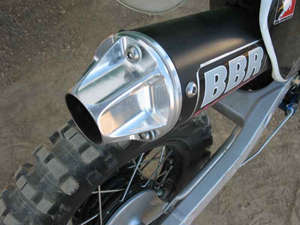 As the evening rolled around I finally pulled the KLX 110 from the trailer and figured out what I would need for night riding. While I wasn’t planning on riding too far from camp, it was only me on a bike so I wanted to be somewhat prepared.
As the evening rolled around I finally pulled the KLX 110 from the trailer and figured out what I would need for night riding. While I wasn’t planning on riding too far from camp, it was only me on a bike so I wanted to be somewhat prepared.
The first thing to do was to make sure the 110 was legal for riding in the desert. With the registration and green sticker up to date the only other item to worry about was the required spark arrestor.
With our BBR pipe there was already a spark arrestor screen insert I could install but even with that, the pipe is rather loud and more suited for the MX track.
To quiet the bike down, I ended up using a spark arrestor/end cap from an XR50 that had been chromed.
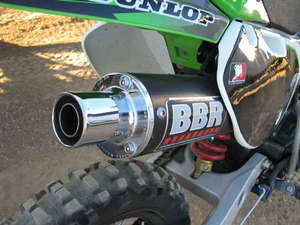 The spark arrestor/endcap fits into the BBR pipe perfectly and uses the same three bolts. This really quiets the bike down with minimal power loss. The bike does rev a little slower but that isn’t a bad thing, since the desert is generally loose and slick anyway. I learned this little trick from a well-known mini MX builder who owns Mototec out of Las Vegas and has built many of the bikes for past Minimoto races.
The spark arrestor/endcap fits into the BBR pipe perfectly and uses the same three bolts. This really quiets the bike down with minimal power loss. The bike does rev a little slower but that isn’t a bad thing, since the desert is generally loose and slick anyway. I learned this little trick from a well-known mini MX builder who owns Mototec out of Las Vegas and has built many of the bikes for past Minimoto races.
After getting the spark arrestor installed I decided to put on my old Garmin GPS so I would make sure I knew where camp was. This could be especially useful if the bike died out in the desert while riding and I had to walk back to camp.
Installing the GPS was made easy by the use of a Touratech mount I picked up used from a friend recently. I had always wanted one but they are so expensive new I just couldn’t justify the cost, until now.
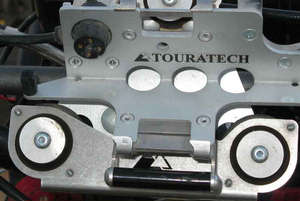 The nice thing about Touratech mount is that the GPS can be powered by just batteries and is much less prone to shut-off due to vibration or shock of riding, because of the damping built into the mount. Without the mount the GPS will cut out and just turn off while riding with just batteries. On my big bike I hardwire the GPS to the battery to avoid this issue, but on the 110 I just needed it to help navigate to camp so using batteries was fine.
The nice thing about Touratech mount is that the GPS can be powered by just batteries and is much less prone to shut-off due to vibration or shock of riding, because of the damping built into the mount. Without the mount the GPS will cut out and just turn off while riding with just batteries. On my big bike I hardwire the GPS to the battery to avoid this issue, but on the 110 I just needed it to help navigate to camp so using batteries was fine.
As the sun was setting I decided to wire a plug into the Kawasaki to allow me to try and run a Cyclops 50 watt Halogen helmet light I had picked up used off the internet recently, but hadn’t had a chance to try it. Even though I knew it would probably be too much for the 110s lighting coil, why not try it?
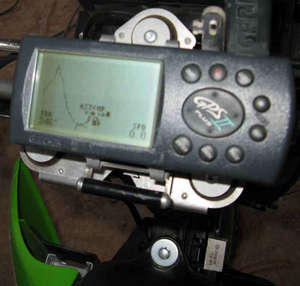 To save time and allow a quick test I used the crimp-on connectors on the end of the plug to tap into the bikes harness. Just as the sun went down I finished the wiring and fired up the bike. The 8” 55-watt headlight and the 50-watt helmet light were indeed too much for the 110, causing both to turn very yellow and dim. Trying one at a time was fine but not both. Even when putting in a 35 watt halogen bulb into the helmet light the results were the same. Running a helmet light off the 110 in addition to the 8” light was a no-go.
To save time and allow a quick test I used the crimp-on connectors on the end of the plug to tap into the bikes harness. Just as the sun went down I finished the wiring and fired up the bike. The 8” 55-watt headlight and the 50-watt helmet light were indeed too much for the 110, causing both to turn very yellow and dim. Trying one at a time was fine but not both. Even when putting in a 35 watt halogen bulb into the helmet light the results were the same. Running a helmet light off the 110 in addition to the 8” light was a no-go.
Not to be left out in the dark without a helmet light as backup, I brought out the helmet light of helmet lights. The Cyclops Solstice HID helmet light is an intense spot beam of very white light that is great for high speed desert riding. It is also a good light to compliment a bike headlight, exactly my plan so that I can turn my head and still see what lies ahead in the night. I had purchased the Solstice and two battery packs from Cyclops a while back when they had a sale but had only used it once on my big bike As my only light on that ride it worked great for seeing what is coming up ahead in the distance but I still wanted a little more beam off to the sides closer to the bikes.
All geared up and ready to ride, the KLX fired right up and the 8” race light was alive. Amazing how much a good reflector can do for giving good light coverage. Not only did it reach far out in front of the bike but the 55-watts of halogen light had a pretty wide beam, giving good visibility on both sides of the bike as well. In addition the soft light of the halogen bulb really does allow the terrain details to be seen giving the rider time to react. The only negative with running only a bike-mounted light is that when you turn your head to look to the side everything is black and you can’t see what is out there unless you actually turn the bike in that direction. For this added visibility it was time to mount up the Solstice HID.
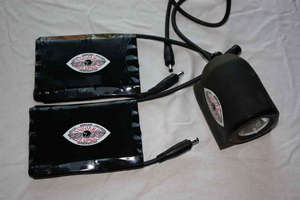 The Solstice HID helmet light is designed to be run off of batteries or a bike with DC power, which usually means a battery or capacitor must be on board the bike. Since our KLX110 has only AC power available, at the moment at least, we opted for using the two “Stack Pack” NiMH batteries that came with the light when purchased. The batteries fit easily in a camelback or waist tool pack and the light itself comes with a long cord with a very strong connector to ensure trouble free use.
The Solstice HID helmet light is designed to be run off of batteries or a bike with DC power, which usually means a battery or capacitor must be on board the bike. Since our KLX110 has only AC power available, at the moment at least, we opted for using the two “Stack Pack” NiMH batteries that came with the light when purchased. The batteries fit easily in a camelback or waist tool pack and the light itself comes with a long cord with a very strong connector to ensure trouble free use.
When the light is first turned on it takes a few seconds to get going but then wow! An intense white spot light is the best way to describe the Solstice and it had no problem lighting up the hillside ¼ mile away.
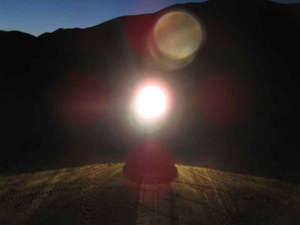 |
| Headlight only |
With both lights blazing, the GPS working and a radio in my Camelback and one back at camp I headed off to explore the desert a bit. I rode over to a few adopt-a-cabins I had marked on the GPS from previous outings. After looking at the cabins I did some play riding on a little track I came across and then headed off for some exploring.
Along the way I discovered what must have been an old cement watering hole. Since it was empty I dropped in and rode around the edges a few laps, it was kind of like riding in an empty swimming pool, in the dark! I popped out of the watering hold and continued my journey to another old miner’s cabin located in a canyon up a sandwash a bit. It feels a bit eerie to be riding in the dark alone, especially when an old mining cabin comes into view out of the darkness.
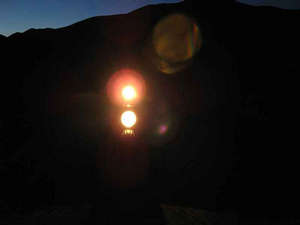 |
| Headlight and Helmet Light |
On the way back to camp I had a blast darting in and out of the desert brush. The 8” headlight provided awesome light in front and to the sides of the bike. It allowed me to see changes in the terrain and didn’t mess with my depth perception at all. The Solstice is amazing at focusing on a wide spot anywhere you look. It could be used as the only light but for me I prefer to have a little extra light directly in front and on the sides of the bike. In addition the intensity of the HID light makes it difficult at times to read the changes in terrain, at least compared to the halogen light. The HID along with the halogen though provided a great combination and didn’t have any strange effects on my vision as I have heard it can for some.
Lastly, once it gets dusty the helmet light really lights up the dust in front of your face making it very difficult to see more than a few feet in front of you. This is a possible hazard if it is really dusty out, if not then not a problem. With the headlight on the bike, the dust doesn’t interfere with your vision because isn’t lighting up the dust right in front of your eyes, something you should consider if you are planning to run just a helmet light.
For the few hours of riding I did close to camp I had a blast. Night riding is addictive and has the added benefit of less people out riding at the same time as you are. In the future I plan to try out a pair of HID helmet lights, one flood and one spot; to see if that makes reading the terrain in front of me easier. In any case if you have never tried night riding I highly encourage you to give it a go.
-et


 Your Privacy Choices
Your Privacy Choices